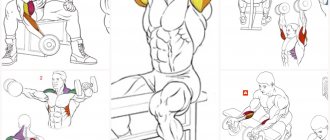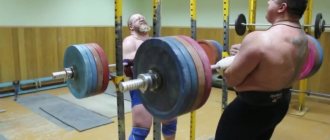Scientific research
During training, a person produces two types of hormones - anabolic and catabolic. The first group includes testosterone, somatotropin (growth hormone) and insulin. They help restore muscles that are damaged during physical activity, and also participate in the construction of new muscle tissue.
Somatotropin, in addition to the muscle restoration function, strengthens bone and connective tissue, reduces body fat, and causes muscle growth.
The catabolic hormones cortisol and glacogon increase blood glucose and stimulate metabolism, but in large quantities they provoke an increase in blood pressure, worsen the protective properties of the immune system, destroy muscle tissue and prevent the construction of new ones.
Cortisol and glacagon destroy muscle tissue and prevent the construction of new ones.
After conducting a number of studies, it was found that the first 20 minutes of training consume glycogen from the muscles, and the next 20 - from the liver. That is why the optimal duration of exercise in the gym is 40-45 minutes. After 45 minutes of training, cortisol levels increase and catabolic processes begin, which have a detrimental effect on muscles.
The permissible peak of cortisol is observed at the 60th minute of training, so training beyond this time is not only impractical, but also dangerous. What could this mean:
- Decreased production of testosterone and somatotropin;
- Increased risk of injury;
- Overtraining.
To properly build a training program, it is enough to take into account two points: testosterone, which is responsible for the progress of athletes, is produced in the first 30-45 minutes of training, and the production of cortisol, which destroys muscles, begins after 45 minutes.
Duration of high-intensity training (HIIT) for fat burning
The duration of high-intensity training, when the body uses both the aerobic energy system and anaerobic (and more so the second) for energy, should average 20-30 minutes. During this time, the body metabolically adapts to the high intensity of exercise and begins to burn its own fat in order to maintain this intensity at the required level for a short period of time.
Read more about HIT in my article Interval training - enemy of fat No. 1.
And after 20-30 minutes of such intense training, the body begins to consume several times more oxygen than after regular aerobic or strength training. And this in turn leads to even greater burning of subcutaneous fat. So 20 minutes a day will be enough for you to burn fat, lose weight without losing your muscles.
Practical advice
Some people who have just started working out in the gym make a number of mistakes:
- Exercising too much (more than 1 hour);
- They do little (less than half an hour);
- They use a large number of simulators and equipment (more than 5-7 units).
Long-term training negatively affects the state of the hormonal system responsible for the athlete’s progress.
If short workouts and chaotic use of more than seven exercise machines in one visit are unlikely to bring visible results, then overdoing it in terms of duration of classes can cause great harm:
- The condition of the muscular system deteriorates. During training, the body experiences stress, and muscles are damaged, because without this their growth is impossible. That is why they need recovery, on which the success of their studies also largely depends. If you exercise too often and for a long time, the muscular system will not have time to recover;
- Lack of oxygen. Energy production during weightlifting exercises lasting less than two minutes is performed without oxygen. Low-intensity long-term training, on the contrary, actively uses it to burn fat and glycogen reserves;
- Overtraining. This is the main enemy of athletes: until the muscles are at least partially restored, there is no point in going to the next workout. This condition is usually accompanied by catabolic processes to a greater extent than with moderate physical activity.
The duration of the workout depends mainly on the program: for example, aerobic training for fat burning should last from 40 to 60 minutes, while training with barbells and strength training equipment should be limited to 45 minutes. Pre-warm-up is not included in the total duration of the lesson.
The most popular are two training systems:
- Split: individual muscle groups are worked out in one session;
- Fullbody (circuit training): involves working on all muscles.
In the first case, most often a large number of repetitions and a minimum of approaches are performed, between which there is a long rest (up to 1 minute), and in the second the opposite is true: the frequency of repetitions decreases, but the approaches increase, and the rest between them is reduced to 10-20 seconds. This also needs to be taken into account when building a training program.
What beginners need to know:
- Using a large number of simulators does not guarantee good results. Normally, three basic and two isolating exercises are enough for a workout;
- Long-term training negatively affects the state of the hormonal system responsible for the athlete’s progress: they activate catabolism and prevent anabolism;
- Short sessions (less than half an hour) do not have a significant impact on the result, because the body does not produce enough hormones and other substances to quickly build muscle tissue and burn fat, and the muscles themselves do not receive optimal load.
We're talking about physiology, how many times should you go to the gym?
In addition, in order to take into account technical information, you need to take into account the processes that occur during training. At the moment we will talk about:
- Super compensation;
- Overtraining;
- Recovery.
As you already know, muscle growth occurs not during training, but after it. In order for this process to proceed as safely and favorably as possible, you need to remember about a reasonable recovery period. According to scientists, the average is 24 hours. During this time, the body manages to build new structures and restore energy reserves.
Also, the recovery process is inevitably associated with a phenomenon called supercompensation. This is the period after training during which muscle performance exceeded the initial level. Schematically it looks like this (see figure).
According to the schedule, each next trip to the gym should exactly coincide with the maximum indicator (peak) of supercompensation. During this period, the muscles have already rested and become stronger, but have not yet lost their functional tone.
If training takes place frequently (4 or even more times), then the body simply will not have time to recover. Protein synthesis will occur slowly, catabolic processes will take over, which will ultimately lead to a condition called overtraining. Going to the gym too rarely is also fraught with consequences, since each phase of supercompensation will be in vain, and muscle growth will never be noticeable.
Read a more detailed article on how to build muscles. It talks in detail about supercompensation and what processes take place in the body after training and how to quickly achieve the desired results. Go to article
Conclusion: you need to search for the golden mean for yourself, and also give loads to different muscle groups at different times.
Also, do not forget about those people who go to the gym in order to get rid of extra pounds. Their metabolism is usually either impaired or slower than that of the average person, so standard training clichés cannot be applied to them. If you belong to this category of people, then daily exercise is a must for you. According to scientists, if a person wants to lose weight, then he needs 300 minutes of cardiovascular exercise per week. If we draw an analogy, this will be approximately 1 hour a day with a 5-day training regimen (per week).
Of course, in the end, you can ignore all of the above and go to the gym out of habit, 3 times a week. But still, if you want to achieve more impressive results, then you should rack your brains a little and determine your optimal amount of training time, listening to the body and its characteristics.
Interesting: Arnold Schwarzenegger did not listen to the opinions of others, ignored stereotypes and came up with new rules himself. For example, he recommended that everyone exercise in the gym twice every day (in the mornings and evenings). Do you think he knew a lot about what he was talking about?
How do pharmacology and stimulants affect the duration of training?
After taking pharmacological drugs, many athletes, even after two hours in the gym, practically do not feel tired.
In bodybuilding, pharmacological drugs (steroidal and non-steroidal), as well as isotonics and pre-workout complexes, are widely used. They have different principles of action, but they all have one thing in common - the ability to increase endurance and strength. For this reason, many athletes, even after two hours in the gym, practically do not feel tired, but it is not recommended to exercise for more than 60 minutes:
- Hormones continue to be produced according to the same principle as without drugs (anabolic steroids are an exception, since they enhance the production of male sex hormones);
- Pharmacological non-steroidal drugs for fat burning often weaken the body, especially during drying, and prolonged physical activity can lead to fainting (for example, Metformin, Clenbuterol, etc.).
While taking steroids, training should be as intense as possible, but do not forget about breaks and recovery, which play a key role. Beginners are not recommended to use such drugs.
How to properly organize your training process?
It all depends on the ultimate goal - losing weight or gaining weight - but in both cases the following tips for organizing training will be relevant:
- Do not visit the hall during rush hour. At this time, queues line up at the exercise machines, which increases the rest time between approaches;
- To burn fat, you need to combine strength and aerobic training, and to gain muscle mass, on the contrary, do it on different days;
- Do not be distracted from the exercises: this negatively affects the execution technique and increases time costs;
- Change your training program periodically. A signal to change the program is a deterioration or suspension of progress;
- Use supersets. They increase the intensity level of the activity;
- Take 1.5 liters of still water with you. This will reduce the time spent on trips to the cooler between approaches.
Minimum duration of effective training
The issue of training duration is relevant for any type of physical activity.
Most often, it is the incorrect duration of training that leads to a decrease in efficiency or, on the contrary, to overtraining.
A workout that is NOT LONG LONG enough will at best be a warm-up or regular exercise, a workout that is TOO LONG will begin to destroy muscle fibers, increasing the production of cortisol, the main catabolic hormone.
In this article, you will learn how long a minimum workout should last in order for it to be effective and efficient.
__________________________________________________________________________________________
__________________________________________________________________________________________
How long should the CARDIO load last: duration of training
Many studies have completely changed the idea of effective training, which is why today regular jogging is considered perhaps the worst option for cardio.
There are several reasons for this:
- To get the fat-burning effect from running, the duration of the cardio session should be at least 30-40 minutes;
- With this duration, the body will begin to actively break down not only fat deposits, but also muscle fibers;
- Long, low-intensity running will lead to overall weight loss, but not fat burning or muscle mass preservation. As a result, it is abandoned in many sports, except those where running has a competitive aspect.
__________________________________________________________________________________________
__________________________________________________________________________________________
However, if you like to run in the mornings or evenings, then remember that to lose weight you need to run for at least 20 minutes.
Only after this period the glycogen reserves in the muscles run out and the body begins to use fat depots as an energy source.
Simply put, running for 20 minutes will give you a good workout and energy, keep your muscles toned, but will not lead to any physical or visual changes. Optimally - from 30 to 40 minutes, but no more.
The same applies to the duration of training on an exercise bike and elliptical trainer.
An exception may be rowing due to increased energy consumption.
Cardio types such as HIIT, as well as any other high-intensity work, should be performed for no more than 10 minutes per session. You can do several sessions, but with a break of at least 10 minutes.
How long should STRENGTH training last?
With the duration of strength training, the situation is almost the opposite.
Its duration should not exceed 45 minutes under any circumstances, since after this period testosterone production decreases, bringing the hormone level back to normal, and the cortisol level, on the contrary, increases, triggering catabolic processes.
Therefore, if you want to reduce your training time without losing effectiveness, then short, high-intensity sessions of 15-20 minutes, no more, are best.
With a fairly short rest between sets and repetitions, or even cyclic training, 20 minutes can accommodate working all the muscles of the body or a high-quality split into two muscle groups.
If you take into account training in the gym, then you need to focus on 45 minutes of strength work, not counting the warm-up. For especially busy people, you can reduce the time spent in the gym to 30 minutes + 5 minutes for warm-up, but in this case you will have to do cardio on the rest day.
Summary
IF TO SUM UP THE FOLLOWING VALUES CAN BE HIGHLIGHTED, WHICH WILL ALLOW THE MUSCLES TO GET SUFFICIENT LOAD, KEEP TONE, AND WILL ALSO MAKE ANY TRAINING EFFECTIVE - so the optimal duration of training:
- Strength training at home – 20-25 minutes;
- Strength training in the gym - 50-60 minutes (5 minutes warm-up, 45 minutes main workout, 10 minutes cardio at the end of the session, if there is enough time);
- Low-intensity cardio – 30-40 minutes;
- High intensity cardio – 10-20 minutes.
__________________________________________________________________________________________
__________________________________________________________________________________________










